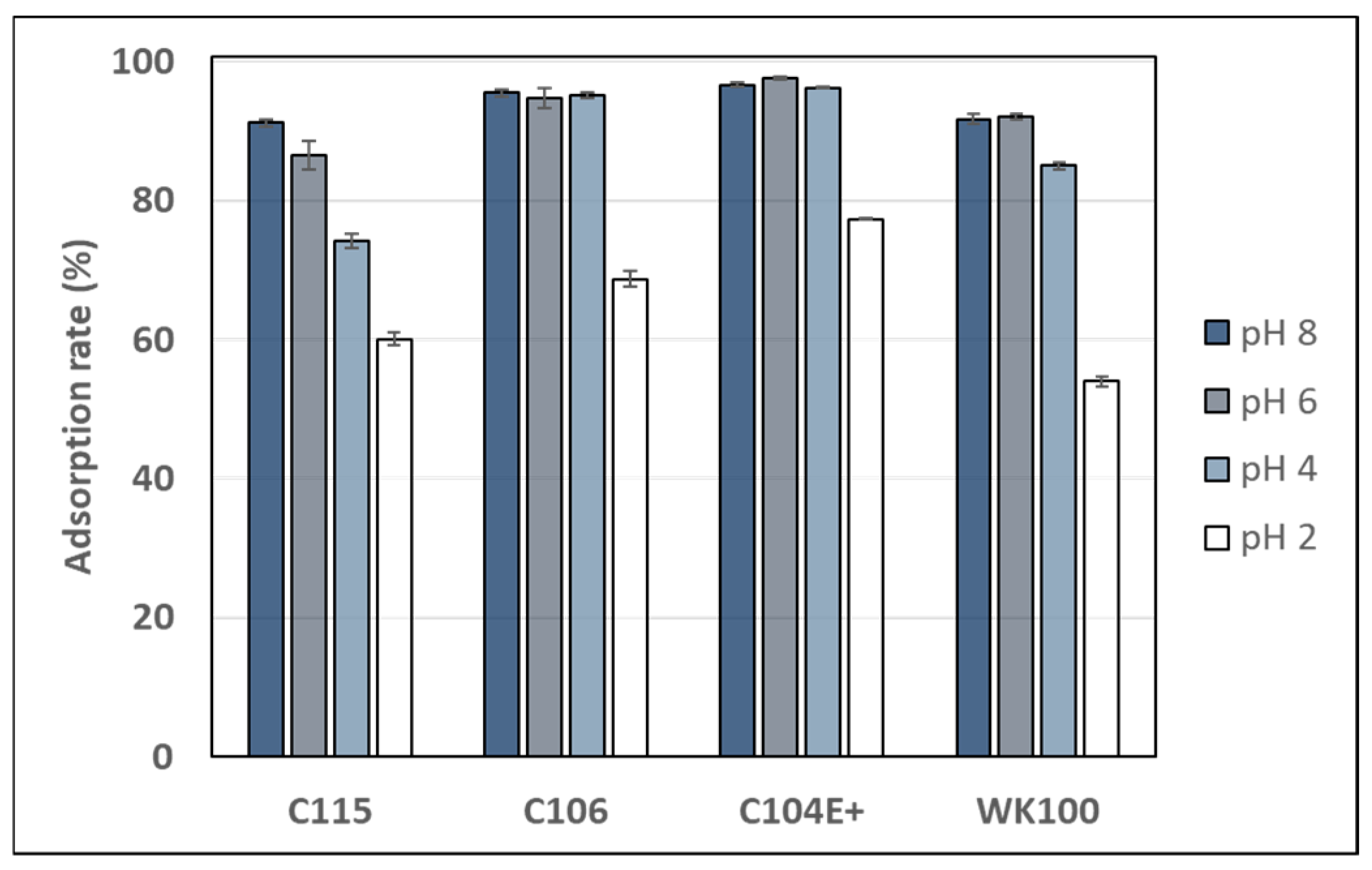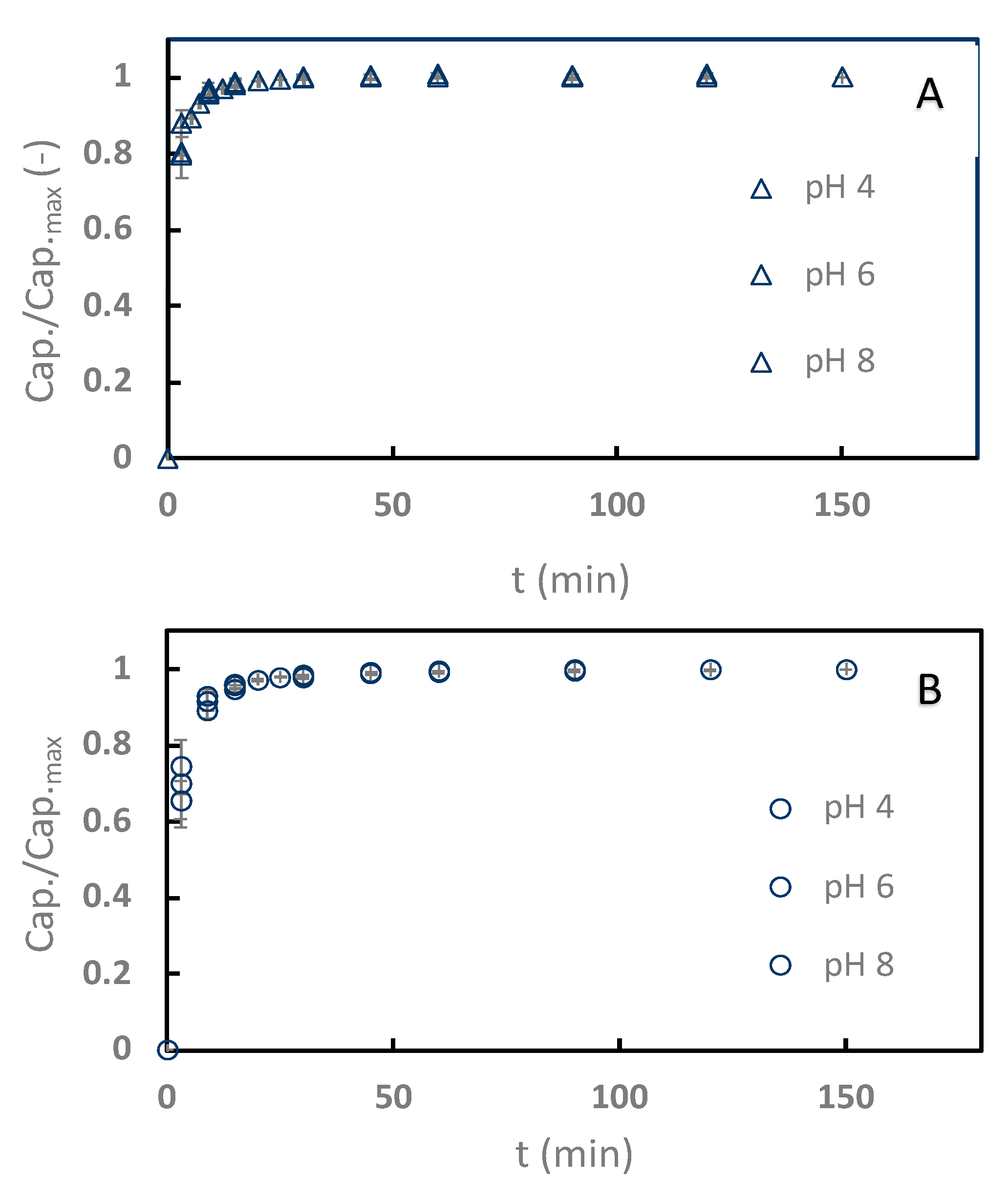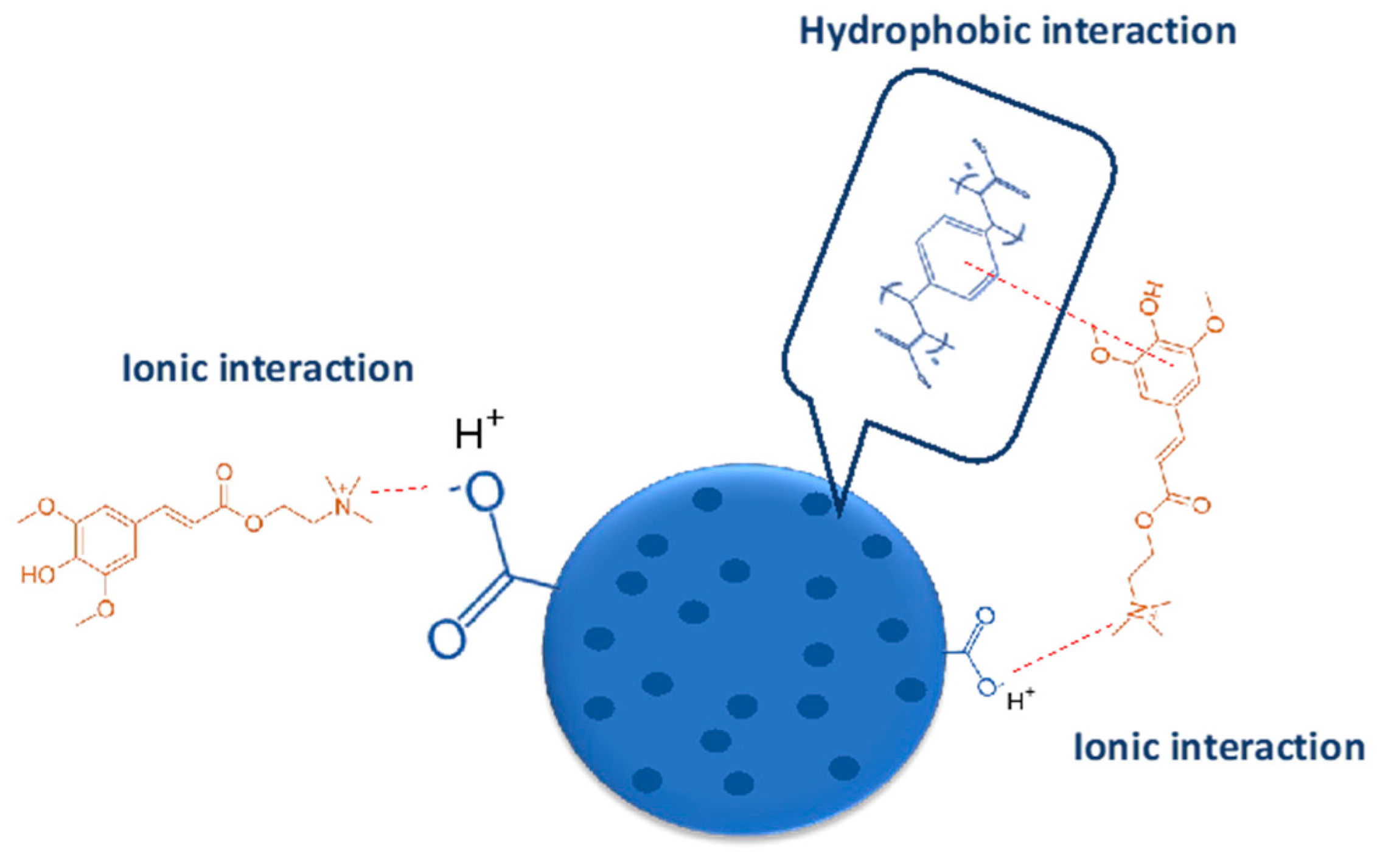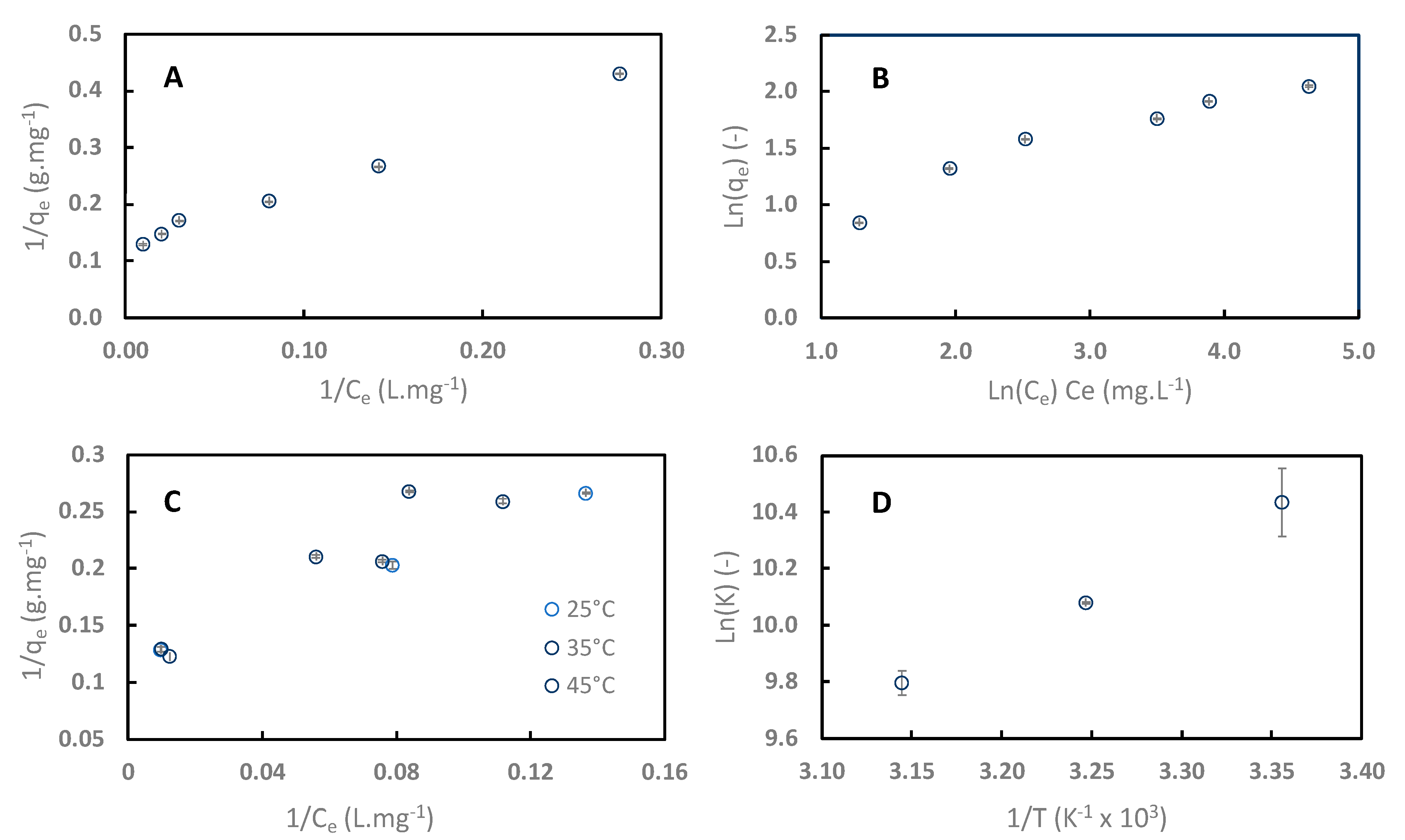Adsorption of Sinapine from Rapeseed Protein Production Effluent to Cation Exchange Resins
Abstract
:1. Introduction
2. Materials and Methods
2.1. Chemicals
2.2. Production of the Sinapine Rich Aqueous Effluent from Rapeseed Meal
2.3. Adsorption/Desorption Study
2.3.1. Resins Screening, Adsorption Kinetics and Isotherms
2.3.2. Sinapine Desorption Kinetics
2.4. Quantification of Sinapine (SN) and Sinapic Acid (SA)
2.5. Data Analysis
3. Results and Discussion
3.1. Cation Exchange Resin Screening
3.1.1. Sinapine Adsorption Rate
3.1.2. Sinapine Adsorption Kinetics
3.1.3. Sinapine Desorption
3.2. Elucidation of the Mechanisms of Sinapine Binding
3.2.1. Kinetic Modeling
| Equations | Parameters | Value |
|---|---|---|
| Pseudo first-order (Equation (5)) | 0.151 | |
| 1.093 | ||
| 0.978 | ||
| Pseudo second-order (Equation (6)) | 0.303 | |
| 5.078 | ||
| >0.999 | ||
| Intraparticle diffusion (Equation (7)) | 0.617 | |
| 2.490 | ||
| 0.931 | ||
| 0.034 | ||
| 4.679 | ||
| 0.831 | ||
| Langmuir (Equation (8)) | 8.091 | |
| 0.114 | ||
| 0.993 | ||
| Freundlich (Equation (9)) | 0.337 | |
| 1.786 | ||
| 0.929 | ||
| Van’t off (Equation (10)) (Equation (11)) | (*) | −25.83 |
| −24.42 | ||
| 0.004 |
3.2.2. Adsorption Isotherms
3.2.3. Determination of Thermodynamic Parameters
3.3. Sinapine and Sinapic Acid Capture from a Rapeseed Protein Isolate Effluent
4. Conclusions
Author Contributions
Funding
Data Availability Statement
Acknowledgments
Conflicts of Interest
Abbreviations
| C | Concentration (mg·L−1) |
| Ce | Concentration at equilibrium (mg·mL−1) |
| C0 | Concentration in the initial sample (mg·mL−1) |
| Cd | Concentration in desorption solution (mg·mL−1) |
| CSE | Conventional solvent extraction |
| ΔG° | Gibbs free energy (kJ·mol−1) |
| ΔH° | Enthalpy variation (kJ·mol−1) |
| ΔS° | Entropy variation (kJ·mol−1·K−1) |
| HPLC-SE | Size exclusion high performance liquid chromatography |
| K | Equilibrium constant (L·mol−1) |
| k1 | Constant rate of PFO (min−1) |
| k2 | Constant rate of PSO (g·mg−1·min−1) |
| KF | Freundlich constant (L·mg−1) |
| ki | Constant rate of intraparticle diffusion equation (mg·g−1·min−0.5) |
| KL | Langmuir constant (L·mg−1) |
| MF | Microfiltration |
| PFO | Pseudo first-order |
| PSO | Pseudo second-order |
| q | Adsorption capacity (mg·g−1) |
| qe | Adsorption capacity at equilibrium (mg·g−1) |
| qm | Maximum saturated monolayer adsorption capacity (mg·g−1) |
| R | Ideal gas constant (8.314 J·mol−1·K−1) |
| RL | Separation factor |
| SA | Sinapic acid |
| SAD | Sinapic acid derivative |
| SN | Sinapine |
| T | Temperature (K) |
| UF | Ultrafiltration |
| UV | Ultraviolet |
| Vd | Volume of the desorption solution (mL) |
| Vi | Sample volume (mL) |
| W | Resin dry weight (g) |
References
- Mouterde, L.M.M.; Peru, A.A.M.; Mention, M.M.; Brunissen, F.; Allais, F. Sustainable Straightforward Synthesis and Evaluation of the Antioxidant and Antimicrobial Activity of Sinapine and Analogues. J. Agric. Food Chem. 2020, 68, 6998–7004. [Google Scholar] [CrossRef]
- Li, X.; Han, L.; Li, Y.; Zhang, J.; Chen, J.; Lu, W.; Zhao, X.; Lai, Y.; Chen, D.; Wei, G. Protective Effect of Sinapine against Hydroxyl Radical-Induced Damage to Mesenchymal Stem Cells and Possible Mechanisms. Chem. Pharm. Bull. 2016, 64, 319–325. [Google Scholar] [CrossRef]
- Boulghobra, D.; Grillet, P.-E.; Laguerre, M.; Tenon, M.; Fauconnier, J.; Fança-Berthon, P.; Reboul, C.; Cazorla, O. Sinapine, but Not Sinapic Acid, Counteracts Mitochondrial Oxidative Stress in Cardiomyocytes. Redox Biol. 2020, 34, 101554. [Google Scholar] [CrossRef]
- Bulua, A.C.; Simon, A.; Maddipati, R.; Pelletier, M.; Park, H.; Kim, K.-Y.; Sack, M.N.; Kastner, D.L.; Siegel, R.M. Mitochondrial Reactive Oxygen Species Promote Production of Proinflammatory Cytokines and Are Elevated in TNFR1-Associated Periodic Syndrome (TRAPS). J. Exp. Med. 2011, 208, 519–533. [Google Scholar] [CrossRef]
- Chen, S.; Jin, Y.-T.; Zhu, Z.-Y.; Wu, L.-T.; Yang, P.; Jin, P.; Xuan, L.-H. In Vivo Study on Site of Action of Sinapine Thiocyanate Following Acupoint Herbal Patching. Evid.-Based Complement. Altern. Med. 2018, 2018, 9502902. [Google Scholar] [CrossRef]
- Li, Y.; Li, J.; Su, Q.; Liu, Y. Sinapine Reduces Non-Alcoholic Fatty Liver Disease in Mice by Modulating the Composition of the Gut Microbiota. Food Funct. 2019, 10, 3637–3649. [Google Scholar] [CrossRef]
- Šebestík, J.; Marques, S.M.; Falé, P.L.; Santos, S.; Arduíno, D.M.; Cardoso, S.M.; Oliveira, C.R.; Serralheiro, M.L.M.; Santos, M.A. Bifunctional Phenolic-Choline Conjugates as Anti-Oxidants and Acetylcholinesterase Inhibitors. J. Enzym. Inhib. Med. Chem. 2011, 26, 485–497. [Google Scholar] [CrossRef]
- Knott, V.; De La Salle, S.; Choueiry, J.; Impey, D.; Smith, D.; Smith, M.; Beaudry, E.; Saghir, S.; Ilivitsky, V.; Labelle, A. Neurocognitive Effects of Acute Choline Supplementation in Low, Medium and High Performer Healthy Volunteers. Pharmacol. Biochem. Behav. 2015, 131, 119–129. [Google Scholar] [CrossRef] [PubMed]
- Pandi, A.; Kalappan, V.M. Pharmacological and Therapeutic Applications of Sinapic Acid—An Updated Review. Mol. Biol. Rep. 2021, 48, 3733–3745. [Google Scholar] [CrossRef] [PubMed]
- Le, T.T.; Framboisier, X.; Aymes, A.; Ropars, A.; Frippiat, J.-P.; Kapel, R. Identification and Capture of Phenolic Compounds from a Rapeseed Meal Protein Isolate Production Process By-Product by Macroporous Resin and Valorization Their Antioxidant Properties. Molecules 2021, 26, 5853. [Google Scholar] [CrossRef]
- Reungoat, V.; Allais, F.; Ducatel, H.; Ioannou, I. Extraction and Purification Processes of Sinapic Acid Derivatives from Rapeseed and Mustard Seed By-Products. Sep. Purif. Rev. 2022, 51, 521–544. [Google Scholar] [CrossRef]
- Gallorini, R.; Aquilia, S.; Bello, C.; Ciardelli, F.; Pinna, M.; Papini, A.M.; Rosi, L. Pyrolysis of Spent Rapeseed Meal: A Circular Economy Example for Waste Valorization. J. Anal. Appl. Pyrolysis 2023, 174, 106138. [Google Scholar] [CrossRef]
- Production, Supply and Distribution (PS&D) Online database, Foreign Agricultural Service (FAS) of United States Department of Agriculture (USDA). 2023. Available online: https://apps.fas.usda.gov/psdonline/app/index.html#/app/downloads (accessed on 1 November 2024).
- Ivanova, P.; Kalaydzhiev, H.; Rustad, T.; Silva, C.; Chalova, V. Comparative Biochemical Profile of Protein-Rich Products Obtained from Industrial Rapeseed Meal. Emir. J. Food Agric. 2017, 29, 170. [Google Scholar] [CrossRef]
- Albe-Slabi, S.; Defaix, C.; Beaubier, S.; Galet, O.; Kapel, R. Selective Extraction of Napins: Process Optimization and Impact on Structural and Functional Properties. Food Hydrocoll. 2022, 122, 107105. [Google Scholar] [CrossRef]
- Defaix, C.; Kapel, R.; Galet, O. Protein Isolate and Process for the Production Thereof. US020200397018A120201224. Available online: https://storage.googleapis.com (accessed on 1 November 2024).
- Beaubier, S.; Defaix, C.; Albe-Slabi, S.; Aymes, A.; Galet, O.; Fournier, F.; Kapel, R. Multiobjective Decision Making Strategy for Selective Albumin Extraction from a Rapeseed Cold-Pressed Meal Based on Rough Set Approach. Food Bioprod. Process. 2022, 133, 34–44. [Google Scholar] [CrossRef]
- Gao, Z.P.; Yu, Z.F.; Yue, T.L.; Quek, S.Y. Adsorption Isotherm, Thermodynamics and Kinetics Studies of Polyphenols Separation from Kiwifruit Juice Using Adsorbent Resin. J. Food Eng. 2013, 116, 195–201. [Google Scholar] [CrossRef]
- Campone, L.; Celano, R.; Rizzo, S.; Piccinelli, A.L.; Rastrelli, L.; Russo, M. Development of an Enriched Polyphenol (Natural Antioxidant) Extract from Orange Juice (Citrus sinensis) by Adsorption on Macroporous Resins. J. Food Qual. 2020, 2020, 1251957. [Google Scholar] [CrossRef]
- Monsanto, M.; Mestrom, R.; Zondervan, E.; Bongers, P.; Meuldijk, J. Solvent Swing Adsorption for the Recovery of Polyphenols from Black Tea. Ind. Eng. Chem. Res. 2015, 54, 434–442. [Google Scholar] [CrossRef]
- Liu, Y.; Bai, Q.; Liu, Y.; Di, D.; Guo, M.; Zhao, L.; Li, J. Simultaneous Purification of Tea Polyphenols and Caffeine from Discarded Green Tea by Macroporous Adsorption Resins. Eur. Food Res. Technol. 2014, 238, 59–69. [Google Scholar] [CrossRef]
- Weisz, G.M.; Schneider, L.; Schweiggert, U.; Kammerer, D.R.; Carle, R. Sustainable Sunflower Processing—I. Development of a Process for the Adsorptive Decolorization of Sunflower [Helianthus annuus L.] Protein Extracts. Innov. Food Sci. Emerg. Technol. 2010, 11, 733–741. [Google Scholar] [CrossRef]
- Tran, T.; Bui, X.; Loan, N.; Anh, N.; Le, T.; Truong, T. Adsorption and Desorption Characteristics and Purification of Isoflavones from Crude Soybean Extract Using Macroporous Resins. Pol. J. Food Nutr. Sci. 2022, 183–192. [Google Scholar] [CrossRef]
- Moreno-González, M.; Girish, V.; Keulen, D.; Wijngaard, H.; Lauteslager, X.; Ferreira, G.; Ottens, M. Recovery of Sinapic Acid from Canola/Rapeseed Meal Extracts by Adsorption. Food Bioprod. Process. 2020, 120, 69–79. [Google Scholar] [CrossRef]
- Datta, C.; Dutta, A.; Dutta, D.; Chaudhuri, S. Adsorption of Polyphenols from Ginger Rhizomes on an Anion Exchange Resin Amberlite IR-400—Study on Effect of pH and Temperature. Procedia Food Sci. 2011, 1, 893–899. [Google Scholar] [CrossRef]
- Jiao, X.; Li, B.; Zhang, X.; Zhang, Q.; Gao, N.; Meng, X. Optimisation of Enrichement and Purification of Polyphenols from Blueberries (Vaccinium SPP) by Macroporous Resins XAD-7HP. Emir. J. Food Agric. 2017, 29, 581. [Google Scholar] [CrossRef]
- Liu, Q.; Gao, Y. Binary Adsorption Isotherm and Kinetics on Debittering Process of Ponkan (Citrus reticulata Blanco) Juice with Macroporous Resins. LWT—Food Sci. Technol. 2015, 63, 1245–1253. [Google Scholar] [CrossRef]
- Park, J.J.; Lee, W.Y. Adsorption and Desorption Characteristics of a Phenolic Compound from Ecklonia cava on Macroporous Resin. Food Chem. 2021, 338, 128150. [Google Scholar] [CrossRef]
- Frascari, D.; Rubertelli, G.; Arous, F.; Ragini, A.; Bresciani, L.; Arzu, A.; Pinelli, D. Valorisation of Olive Mill Wastewater by Phenolic Compounds Adsorption: Development and Application of a Procedure for Adsorbent Selection. Chem. Eng. J. 2019, 360, 124–138. [Google Scholar] [CrossRef]
- Abdullah, M.A.; Chiang, L.; Nadeem, M. Comparative Evaluation of Adsorption Kinetics and Isotherms of a Natural Product Removal by Amberlite Polymeric Adsorbents. Chem. Eng. J. 2009, 146, 370–376. [Google Scholar] [CrossRef]
- Gavach, M. Détoxification de Condensats de Distillerie par Osmose Inverse, Échange D’ions et Leur Combinaison. Application au Recyclage en Fermentation Alcoolique. Ph.D. Thesis, AgroParisTech, Massy, France, 2010. [Google Scholar]
- William Kajjumba, G.; Emik, S.; Öngen, A.; Kurtulus Özcan, H.; Aydın, S. Modelling of Adsorption Kinetic Processes—Errors, Theory and Application. In Advanced Sorption Process Applications; Edebali, S., Ed.; IntechOpen: Rijeka, Croatia, 2019. [Google Scholar] [CrossRef]
- Firdaous, L.; Fertin, B.; Khelissa, O.; Dhainaut, M.; Nedjar, N.; Chataigné, G.; Ouhoud, L.; Lutin, F.; Dhulster, P. Adsorptive Removal of Polyphenols from an Alfalfa White Proteins Concentrate: Adsorbent Screening, Adsorption Kinetics and Equilibrium Study. Sep. Purif. Technol. 2017, 178, 29–39. [Google Scholar] [CrossRef]
- Wang, Z.; Peng, S.; Peng, M.; She, Z.; Yang, Q.; Huang, T. Adsorption and Desorption Characteristics of Polyphenols from Eucommia ulmoides Oliv. Leaves with Macroporous Resin and Its Inhibitory Effect on α-Amylase and α-Glucosidase. Ann. Transl. Med. 2020, 8, 1004. [Google Scholar] [CrossRef]
- Slabi, S.; Mathé, C.; Framboisier, X.; Defaix, C.; Mesieres, O.; Galet, O.; Kapel, R. A New SE-HPLC Method for Simultaneous Quantification of Proteins and Main Phenolic Compounds from Sunflower Meal Aqueous Extracts. Anal. Bioanal. Chem. 2019, 411, 2089–2099. [Google Scholar] [CrossRef] [PubMed]
- Siger, A.; Czubinski, J.; Dwiecki, K.; Kachlicki, P.; Nogala-Kalucka, M. Identification and Antioxidant Activity of Sinapic Acid Derivatives in Brassica napus L. Seed Meal Extracts. Eur. J. Lipid Sci. Technol. 2013, 115, 1130–1138. [Google Scholar] [CrossRef]
- Jurado-Davila, V.; Oshiro, G.P.; Estumano, D.C.; Féris, L.A. Immobilization of Marbofloxacin for Water Treatment by Adsorption in Batch Scale and Fixed-Bed Column: Applying of Monte Carlo Bayesian Modeling. Ind. Eng. Chem. Res. 2024, 63, 9976–9987. [Google Scholar] [CrossRef]
- Jurado-Davila, V.; Reolon, L.S.; Nunes, K.G.P.; Cardoso Estumano, D.; Féris, L.A. Classical and Bayesian Computational Statistics Applied to Acetylsalicylic Acid Mitigation in Aqueous Solutions: Study of Batch Scale, Kinetic Modeling, and Fixed-Bed Column Adsorption. Ind. Eng. Chem. Res. 2024, 63, 9943–9954. [Google Scholar] [CrossRef]
- De Oliveira, J.T.; Nunes, K.G.P.; Cardoso Estumano, D.; Féris, L.A. Applying the Bayesian Technique, Statistical Analysis, and the Maximum Adsorption Capacity in a Deterministic Way for Caffeine Removal by Adsorption: Kinetic and Isotherm Modeling. Ind. Eng. Chem. Res. 2024, 63, 1530–1545. [Google Scholar] [CrossRef]
- Thiel, A.; Muffler, K.; Tippkötter, N.; Suck, K.; Sohling, U.; Hruschka, S.M.; Ulber, R. A Novel Integrated Downstream Processing Approach to Recover Sinapic Acid, Phytic Acid and Proteins from Rapeseed Meal: A Novel Downstream Processing Approach for Rapeseed Meal. J. Chem. Technol. Biotechnol. 2015, 90, 1999–2006. [Google Scholar] [CrossRef]
- Thiel, A.; Tippkötter, N.; Suck, K.; Sohling, U.; Ruf, F.; Ulber, R. New Zeolite Adsorbents for Downstream Processing of Polyphenols from Renewable Resources. Eng. Life Sci. 2013, 13, 239–246. [Google Scholar] [CrossRef]
- Kessoum, M.; Caqueret, V.; Chedeville, O.; Cagnon, B.; Bostyn, S.; Porte, C. Etude de la cinétique et de la thermodynamique d’adsorption de composés phénoliques en monosolutés et en mélange sur charbon actif. In Recent Progress in Chemical Engineering, Proceedings of the 12th Congress of French Chemical Engineering Society, Marseille, France, 14 October 2009; ResearchGate: Berlin, Germany, 2009. [Google Scholar]
- Li, X.; Zhou, X.; Mu, J.; Lu, L.; Han, D.; Lu, C.; Wang, M. Thermodynamics and Kinetics of p-Aminophenol Adsorption on Poly(Aryl Ether Ketone) Containing Pendant Carboxyl Groups. J. Chem. Eng. Data 2011, 56, 4274–4277. [Google Scholar] [CrossRef]








| Resin | Type | Matrix | Functional Grouping | pKa |
|---|---|---|---|---|
| WK100 | Low cation exchanger | Methacrylic–porous | COO−; H+ | - |
| C106 | Low cation exchanger | Cross-linked polyacrylic with divinylbenzene–macroporous | COO−; H+ | ~3.5 |
| C115 | Low cation exchanger | Cross-linked polymethacrylic with divinylbenzene–macroporous | COO−; H+ | 5.5–6.0 |
| C 104 E+ | Low cation exchanger | Cross-linked polyacrylic acid–porous | COO−; H+ | 4 |
| T°K | Ln K | ΔH° (kJ·mol−1) | ΔS° (kJ·mol−1·K−1) | ΔG° (kJ·mol−1) |
|---|---|---|---|---|
| 298 | 10.427 | −24.428 | 0.004 | −25.834 |
| 308 | 10.078 | −25.249 | ||
| 318 | 9.807 | −25.369 |
| One Step Des. | Two Step Des. | |||||||
|---|---|---|---|---|---|---|---|---|
| Process Step | Ads. | Des. 1 | Des. 1 | Des. 2 | ||||
| Eluent | EtOH (50% v/v) | EtOH (50% v/v) | EtOH/HCl | |||||
| Ads. (%) | SD | Des. (%) | SD | Des. (%) | SD | Des. (%) | SD | |
| Sinapine (SN) | 80.6 | 1.2 | 72.4 | 1.6 | 7.2 | 0.2 | 63.3 | 1.2 |
| Sinapic acid (SA) | 64.1 | 1.5 | 64.5 | 7.1 | 86.6 | 1.1 | 20.2 | 1.8 |
Disclaimer/Publisher’s Note: The statements, opinions and data contained in all publications are solely those of the individual author(s) and contributor(s) and not of MDPI and/or the editor(s). MDPI and/or the editor(s) disclaim responsibility for any injury to people or property resulting from any ideas, methods, instructions or products referred to in the content. |
© 2025 by the authors. Licensee MDPI, Basel, Switzerland. This article is an open access article distributed under the terms and conditions of the Creative Commons Attribution (CC BY) license (https://creativecommons.org/licenses/by/4.0/).
Share and Cite
Kdah, F.Z.; Aymes, A.; Beau, L.; Ropars, A.; Frippiat, J.-P.; Kapel, R. Adsorption of Sinapine from Rapeseed Protein Production Effluent to Cation Exchange Resins. Separations 2025, 12, 10. https://doi.org/10.3390/separations12010010
Kdah FZ, Aymes A, Beau L, Ropars A, Frippiat J-P, Kapel R. Adsorption of Sinapine from Rapeseed Protein Production Effluent to Cation Exchange Resins. Separations. 2025; 12(1):10. https://doi.org/10.3390/separations12010010
Chicago/Turabian StyleKdah, Fatima Zahra, Arnaud Aymes, Luna Beau, Armelle Ropars, Jean-Pol Frippiat, and Romain Kapel. 2025. "Adsorption of Sinapine from Rapeseed Protein Production Effluent to Cation Exchange Resins" Separations 12, no. 1: 10. https://doi.org/10.3390/separations12010010
APA StyleKdah, F. Z., Aymes, A., Beau, L., Ropars, A., Frippiat, J.-P., & Kapel, R. (2025). Adsorption of Sinapine from Rapeseed Protein Production Effluent to Cation Exchange Resins. Separations, 12(1), 10. https://doi.org/10.3390/separations12010010






